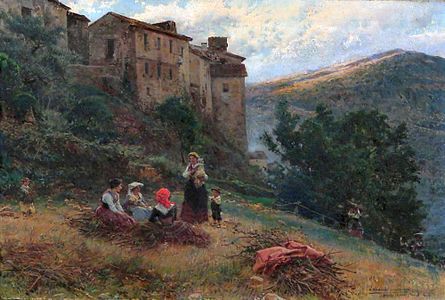Mariano Barbasán
Mariano Barbasán | |
|---|---|
Realist |
Mariano Barbasán Lagueruela (3 February 1864 – 22 July 1924) was a Spanish painter of
Realist style; later influenced by Impressionism
.
Biography
He was born in
Real Academia de Bellas Artes de San Carlos in Valencia). Upon graduating, he moved to Madrid and became a historical painter; specializing in scenes from the history of Toledo, which he visited frequently.[1] He also did some scenes from literature and presented his rendering of the Walpurgisnacht of Faust at the National Exhibition of Fine Arts
.
In 1889, thanks to his painting "Joseph Interpreting the Cup-bearer's Dream", he received a stipend from the "Diputación Provincial de Zaragoza" to continue his studies at the Spanish Academy in Rome. While there, he painted mostly landscapes and scenes of rural life.[1]
He eventually decided to live there and opened a studio; making occasional trips to
plein aire. He held frequent exhibits throughout Germany, Austria and England, but not in Spain, as a result of which he was little-known in his home country. In 1912, he lived in Montevideo for a short time while overseeing two exhibitions there.[2]
He stayed in
Francisco Pradilla. It was two years later that he held his first retrospective exhibition, at the Central Market in Zaragoza.[2] He died in Zaragoza
, aged 60.
In 1925, his son organized a new, more formal exhibition that helped establish his reputation in Spain.
Selected paintings
-
Landscape near Anticoli Corrado
-
Village Street
-
Joseph Interpreting
the Cup-bearer's Dream
References
- ^ a b Biographical notes @ the Museo del Prado.
- ^ a b Brief biography @ the Gran Enciclopedia Aragonesa.
Further reading
- Caja Rural de Aragón, Mariano Barbasán. 1864-1924 (exhibition catalog) Cajalón, 1995 ISBN 84-89640-00-9
External links
Wikimedia Commons has media related to Mariano Barbasán.



